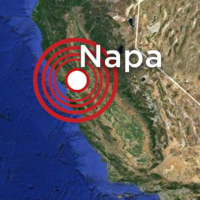Where is the State's Earthquake Alert System?
 (graphic: ABC News)
(graphic: ABC News)
It's been 146 years since a physician, Dr. J.D. Cooper, wrote an editorial in the San Francisco Evening Bulletin that laid out his vision for an alert system to give the city advanced warning of an approaching earthquake.
Most everyone since has agreed that it was a fine idea and scientists in California helped develop one . . . for Japan, which gave them a 100-second heads-up when a 9.0 quake rocked Fukushima in 2011 and killed nearly 16,000 people.
But California has only pieces of a demonstration system that gave a 10-second alert to scientists at the University of California Berkeley Seismo Lab Sunday when a 6.0 shaker hit Napa, but was of no help to folks at the epicenter. “The system worked very well,” Earthquake Early Warning System Director Richard Allen told the San Francisco Chronicle. If actually deployed, San Jose would have received a 25-second warning, he said.
Governor Jerry Brown declared a state of emergency for the region north of San Francisco after the 3:20 a.m. quake damaged buildings (including some that had been retrofitted), knocked out electricity to thousands and sent at least 87 people to the hospital. Three were critically injured, but no deaths were reported. The quake was centered 6 miles southwest of Napa and was the largest in the state since the 6.9 Loma Prieta shaker in 1989.
Some roads buckled, but bridges stayed aloft, gas lines didn't explode (although 50 breaks were reported), train tracks were intact and no tall buildings fell down. Several historic brick buildings in downtown Napa were heavily damaged, 100 homes were deemed uninhabitable and small, scattered fires were reported. A fair number of wine bottles broke.
Scientists at the U.S. Geological Survey (USGS) told the Chronicle that there was a 54% chance of significant aftershocks within the next seven days that could cause more damage.
“Clearly we didn’t win,” Napa shoe store owner Nick Brennan told the New York Times, standing amid 8,000 pairs of scattered shoes. “It’s over, we clean up, we try to build it a little stronger.”
Part of that future preparation may include work on a functional alert system.
Governor Brown signed a bill into law last September which directs the Office of Emergency Services (Cal OES) to develop a “comprehensive statewide earthquake early warning system,” but doesn't provide funding for it.
SB 135, introduced by state Senator Alex Padilla, made provisions of the bill contingent on finding money for the system by January 2016. The legislation replaced existing law that merely required the office “to develop and distribute an educational pamphlet for use by kindergarten, any of grades 1 to 12, inclusive, and community college personnel to identify and mitigate the risks posed by nonstructural earthquake hazards.”
At the time of the bill's passage, it was estimated that it would take around $80 million to build a system whose benefits would include a 40-to-50-second warning for downtown Los Angeles that thunder was rolling down from the San Andreas Fault. The Los Angeles Times says that a lack of funding has slowed the project.
The USGS says on its website that the federal government has responsibility for issuing quake alerts under the Disaster Relief Act of 1974 and is developing the system in collaboration with the California Institute of Technology, UC Berkeley and the University of Washington. But apparently it hasn't received a lot of federal money either.
The system would rely on hundreds of sensors placed strategically around the state to detect movement of the Earth traveling at the speed of sound and send information about it around the state at the speed of light. That is considerably faster than government moves.
–Ken Broder
To Learn More:
Earthquake Cracks, Buckles Roads, but Leaves Bridges OK (by Michael Cabanatuan, San Francisco Chronicle)
Little-Known Fault Suspected in Northern California Quake (by David Perlman, San Francisco Chronicle)
Earthquake Early-Warning System Gave 10-Second Alert before Napa Quake Felt (Los Angeles Times)
State of Emergency Declared after California Earthquake (by Jim Kerstetter and Ian Lovett, New York Times)
Earthquake Warning System Conceived in California Helps Japan . . . but not California (by Ken Broder, AllGov California)
- Top Stories
- Controversies
- Where is the Money Going?
- California and the Nation
- Appointments and Resignations
- Unusual News
- Latest News
- California Forbids U.S. Immigration Agents from Pretending to be Police
- California Lawmakers Urged to Strip “Self-Dealing” Tax Board of Its Duties
- Big Oil’s Grip on California
- Santa Cruz Police See Homeland Security Betrayal in Use of Gang Roundup as Cover for Immigration Raid
- Oil Companies Face Deadline to Stop Polluting California Groundwater





